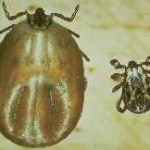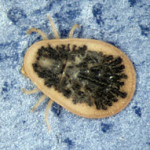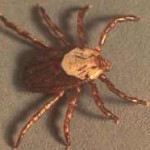Ticks – blood-feeding parasites – are most dangerous for the diseases they can carry. When traveling in areas known to have ticks present, it is important to take precautionary measures such as wearing protective clothing, using tick repellent, and conducting tick checks, say entomologists with Colorado State University.
Colorado State University has been conducting research on insects for years and has compiled information to help people stay safe from diseases carried by ticks. CSU’s information about ticks can be found here. Traducción español es disponible, a través de la pestaña “Convertia al Español” en el sitio web.
All ticks have a typical lifecycle that involves four distinct stages: egg, tiny six-legged larva or seed tick, nymph and adult, according to CSU entomologists. It is the adults that occasionally feed on people. Ticks are highly sensitive to carbon dioxide, which is exhaled by animals as they breathe, and seek it out. They often are poised at the top of vegetation so they can readily cling to passing animals.
How to avoid ticks
- Avoid Tick Habitat
Avoid traveling through areas where ticks are abundant. Ticks are most active in spring and early summer and concentrate where their animal hosts most commonly travel. This includes brushy areas along the edges of fields and woodlands or commonly traveled paths through grassy areas and shrublands.
- Use Tick Repellents
There are a few effective tick repellents. By far the most common is DEET (N,N-diethyl-metatoluamide), the active ingredient in most common insect repellents, such as Cutters and Off!. Apply DEET directly to the skin or to clothing. Repellents are most effective if applied to pants and other areas of the lower body likely to come into contact with ticks.
DEET can be an effective repellent for ticks as well as other biting arthropods, such as chiggers and mosquitoes. However, the following precautions are encouraged:
- On children, do not use high-concentration formulations (above 30 percent).
- Apply the repellent to clothing, rather than to skin.
- Do not apply DEET to hands or other areas that may come into contact with the mouth.
- Do not apply to wounds or irritated skin.
- After use, wash or bathe treated areas, particularly on children.
- Wear Protective Clothing
Long pants, long-sleeved shirts and other clothing can help exclude ticks or keep them from attaching to the skin. Ticks are usually acquired while brushing against low vegetation, so pulling socks over the bottom of the pants leg also is useful. Light-colored clothing can make it easier to find ticks that have been picked up.
- Conduct Tick Checks
Ticks take several hours to settle and begin feeding. This gives you ample time to detect and remove them. The Rocky Mountain wood tick typically takes 12 to 24 hours to start feeding. Therefore, a thorough “tick check” can be an effective alternative to repellents. After walking through areas where ticks might be present, carefully look for and remove any ticks you may have picked up.
How to remove a tick 

Once a tick has become firmly attached to the skin, removal can be difficult and should be done with care. The mouthparts are barbed, so they may remain after removal and allow infection. The recommended procedure for removal of ticks is:
- Grasp the tick with blunt tweezers, as close to the skin as possible. If tweezers are not available and you must use your fingers, cover them with tissue or thin plastic to avoid the possible transmission of any disease organisms, such as tularemia, that the tick may harbor.
- Pull the tick slowly and steadily, straight away from the skin. Try not to crush the tick as you remove it.
- After the tick is removed, treat the feeding site with a disinfectant. Wash your hands when done.
Many other methods have been popularized to remove ticks, such as covering them with petroleum jelly or touching them with a hot match. These methods are not effective.
More information about CSU Extension
Information about ticks and other topics is shared though Colorado State University Extension offices. Colorado State University was founded as a United States land-grant institution and part of its mission is to provide research-based information about topics such as agriculture, nutrition, and health to the citizens of the Colorado. CSU Extension was founded in 1912.
More information about ticks and many other topics can be found at www.Extension.ColoState.edu. Traducción español es disponible, a través de la pestaña “Convertia al Español” en el sitio web.
About the CSU Todos Santos Center
The Colorado State University Todos Santos Center is the university’s first international location and is core to CSU’s mission of teaching, research, service, and outreach.
The Center provides opportunities for CSU students and Baja California Sur residents to collaborate with local partners and businesses to identify needs, conduct research, and produce impactful outcomes.
CSU’s vision in Todos Santos is to cultivate generations of global citizens and to be a part of creating thriving communities through collaboration, experience, and exchange of knowledge in areas such as agriculture, infectious disease, elementary education, environmental and social sustainability, wildlife ecology, veterinary medicine, and public health.